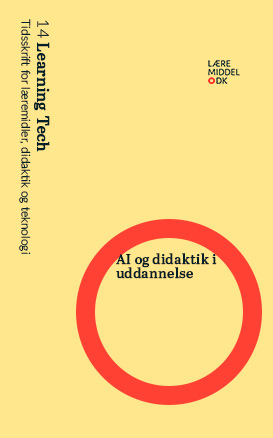The role of AI chatbots in scaffolding: Linking learning outcomes with assessment
DOI:
https://doi.org/10.7146/lt.v9i14.141213Resumé
Emerging discussions highlight the role of chatbots in education, which centres around fundamental perspectives concerning technology as either beneficial or an unnecessary disruption to the learning and assessment processes. However, it is crucial to recognise that no technology can be deemed value-neutral, and technological euphoria often blinds us to the unintended consequences of its use. Hence, there is a need for a practical understanding informed by value-based perspectives to comprehend how the encoded experiences created by ChatGPT transform the teaching of students. This article makes a significant contribution to the field of educational research, as only limited attention has been given to higher education students’ reflections on the pedagogical use of artificial intelligence (AI) chatbots for learning and assessment. The article discusses, through empirical findings, the constructive alignment between learning objectives and assessment when employing AI chatbots. The data collection process revolves around students’ reflective experiences while utilising the potential of ChatGPT, which are subsequently analysed through focused group interviews. The paper, informed by these observational data, presents a conceptual framework for teachers to employ and assess ChatGPT as a means to scaffold learning among students.
Referencer
Biggs, J. (1996). Enhancing teaching through constructive alignment. Higher education, 32(3), 347-364.
Biggs, J. & Tang, C. T. (2007). Teaching for quality learning at university: What the student does (3rd ed.). McGraw-Hill.
Boyatzis, R. E. (1998). Transforming qualitative information: Thematic analysis and code development. Sage Publications.
Carver-Thomas, D. & Darling-Hammond, L. (2017). Teacher turnover: Why it matters and what we can do about it. Learning Policy Institute. Teacher Turnover: Why It Matters and What We Can Do About It | Learning Policy Institute
Cotton, D. R., Cotton, P. A. & Shipway, J. R. (2023). Chatting and cheating: Ensuring academic integrity in the era of ChatGPT. Innovations in Education and Teaching International, 1-12.
Driscoll, M. P. (2000). Psychology of learning for instruction. Allyn & Bacon.
Flyvbjerg, B. (2006). Five misunderstandings about case-study research. Qualitative inquiry, 12(2), 219-245.
Gasior, K. (2013). Education at a glance 2012: OECD indicators. Sociologický časopis/Czech Sociological Review, 49(6), 994-997.
Haleem, A., Javaid, M. & Singh, R. P. (2022). An era of ChatGPT as a significant futuristic support tool: A study on features, abilities, and challenges. BenchCouncil Transactions on Benchmarks, Standards and Evaluations, 2(4), Article 100089.
Harlen, W. (2005). Teachers' summative practices and assessment for learning – tensions and synergies. Curriculum Journal, 16(2), 207-223.
Hassan, R., Ali, A., Howe, C. W. & Zin, A. M. (2022, October). Constructive alignment by implementing design thinking approach in artificial intelligence course: Learners' experience. In AIP Conference Proceedings (Vol. 2433, No. 1). AIP Publishing.
Hughes, G. (2014). Ipsative assessment: Motivation through marking progress. Springer.
Jensen, C. G., Dau, S., Clausen, N. R., Ryberg, T. & Bertel, L. B. (2022). Dilemmaer i translation og transformation af erfaringsbaserede kollaborative læringsformer til digitale læringsplatforme. Læring og Medier, 15(25).
Kasneci, E., Seßler, K., Küchemann, S., Bannert, M., Dementieva, D., Fischer, F. & Kasneci, G. (2023). ChatGPT for good? On opportunities and challenges of large language models for education. Learning and individual differences, 103, 102274.
Lent, J. R. (2017). The patterning instinct: A cultural history of humanity's search for meaning. Prometheus Books.
Ng, D. T. K., Lee, M., Tan, R. J. Y., Hu, X., Downie, J. S. & Chu, S. K. W. (2023). A review of AI teaching and learning from 2000 to 2020. Education and Information Technologies, 28(7), 8445-8501.
Rodríguez-Gómez, G. & Ibarra-Sáiz, M. S. (2015). Assessment as learning and empowerment: Towards sustainable learning in higher education. In Sustainable learning in higher education: Developing competencies for the global marketplace (pp. 1-20). Springer.
Saldaña, J. & Omasta, M. (2016). Qualitative research: Analysing life. Sage Publications.
Selwyn, N. (2011). Education and Technology: Key Issues and Debates. Bloomsbury Publishing. http://ebookcentral.proquest.com/lib/aalborguniv-ebooks/detail.action?docID=661054
Sharma, S. & Yadav, R. (2022). Chat GPT – A technological remedy or challenge for education system. Global Journal of Enterprise Information System, 14(4), 46-51.
Tlili, A., Shehata, B., Aderkwah, M. A., Bozkurt, A., Hickey, D. T., Huang, R. & Agyemang, B. (2023). What if the devil is my guardian angel: ChatGPT as a case study of using chatbots in education. Smart Learning Environments, 10(1), Article 15.
Tromp, N., Hekkert, P. & Verbeek, P. P. (2011). Design for socially responsible behavior: A classification of influence based on intended user experience. Design Issues, 27(3), 3-19.
Wiliam, D. & Thompson, M. (2017). Integrating assessment with learning: What will it take to make it work?. In The future of assessment (pp. 53-82). Routledge.
Williamson, B. (2019). New power networks in educational technology. Learning, Media and Technology, 44(4), 395-398. https://doi.org/10.1080/17439884.2019.1672724
Yin, R. K. (2013). Case study research: Design and methods. Sage Publications. Zawacki-Richter, O., Marín, V. I., Bond, M. & Gouverneur, F. (2019). Systematic review of research on artificial intelligence applications in higher education – where are the educators? International Journal of Educational Technology in Higher Education, 16(1), 1-27.
Zhai, X. (2022). ChatGPT user experience: Implications for education. Available at SSRN 4312418. ChatGPT User Experience: Implications for Education by Xiaoming Zhai :: SSRN
Yderligere filer
Publiceret
Citation/Eksport
Nummer
Sektion
Licens
Forfatterne og Læremiddel.dk.
Må ikke bruges kommercielt.


